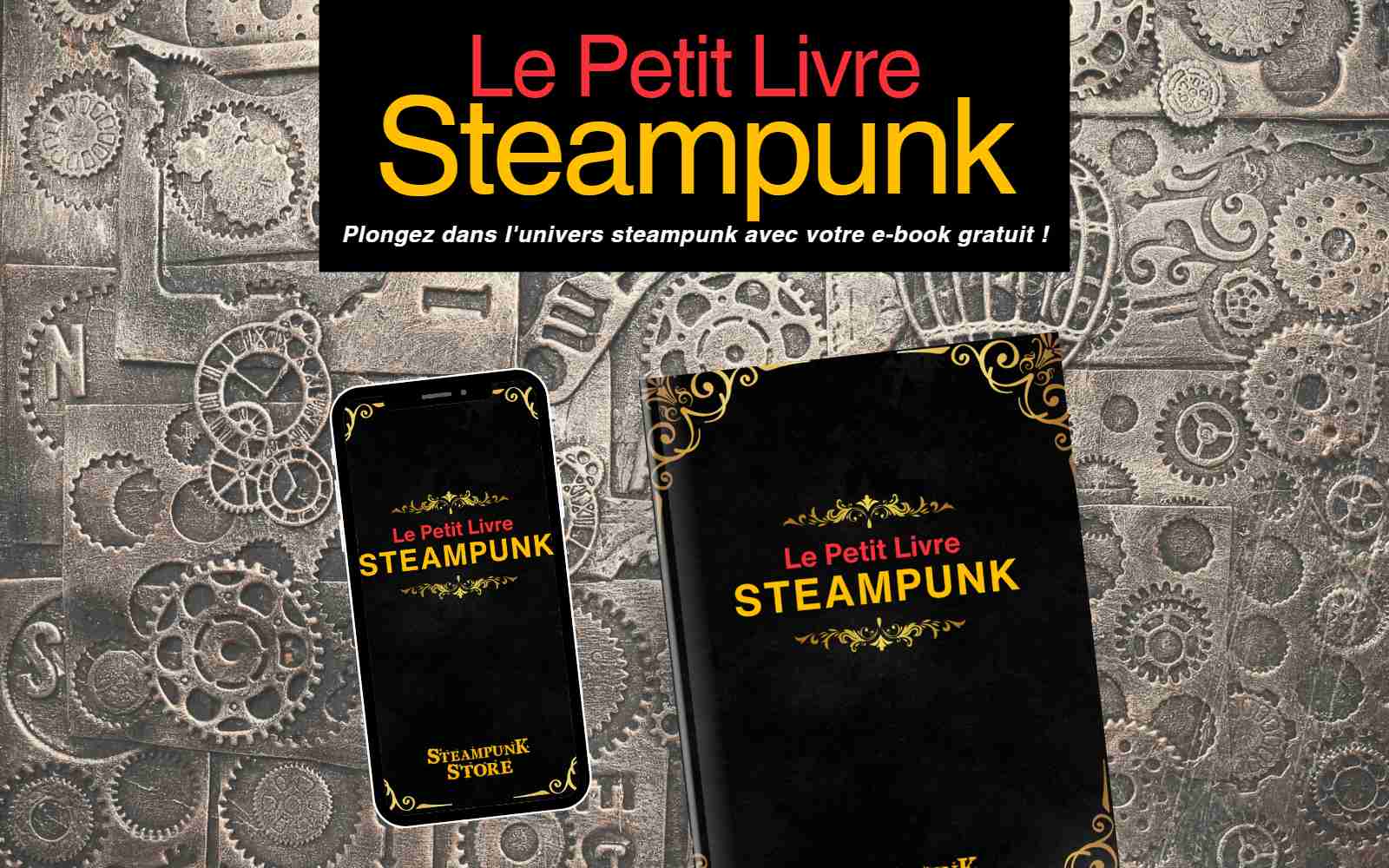
Who has never been fascinated by post-apocalyptic science fiction tales, where humanity confronts its own destruction? In this article, we explore the various facets of this captivating subgenre, addressing the types of post-apocalypse, the impact on society, famous works, and also its intriguing blend with Steampunk. The marriage of these two genres in science fiction works creates captivating narratives, filled with adventure, survival, and extraordinary inventions.
Key Points
🔧 Post-apocalyptic definition: Fictional universe where Earth is devastated by catastrophe, featuring survivors fighting for their lives.
⚙️ Origins: Post-apocalyptic fiction has ancient roots, while steampunk draws inspiration from the Victorian era and Jules Verne's works.
🛠️ Convergences: Both genres intersect by reinventing reality, addressing moral and political issues.
🌍 Ecopunk: Addresses natural disasters and their consequences, highlighting our planet's fragility.
⚛️ Atompunk: Blending nostalgia with the dark reality of a post-nuclear war world.
🧬 Biopunk: Concerns pandemics and genetic manipulation, exploring ethical dilemmas.
👽 Astropunk: Alien invasions and their impacts, confronting humanity with threats from beyond.
📚 Literary works: "Mortal Engines," "The Windup Girl," "City of Saints and Madmen," "The Difference Engine."
🎬 Films: "The City of Lost Children," "9."
🎮 Video games: "Dishonored," "BioShock Infinite," "Frostpunk."
Continue reading to learn more about this fascinating mechanical convergence!
The Post-Apocalyptic Science Fiction Universe
Definition of Post-Apocalyptic Fiction
The term "post-apocalyptic" designates a fictional universe in which Earth has been devastated by chaos or catastrophe, whether through nuclear war, pandemic, natural disaster, or alien invasion. These narratives often feature survivors struggling for their existence in a ruined world, functioning like intricate survival mechanisms in a broken clockwork reality.
Origins of Post-Apocalyptic and Steampunk Genres
The concept of post-apocalyptic fiction traces back to antiquity, with catastrophe narratives like the Epic of Gilgamesh, which describes a devastating flood. However, the genre truly developed in the 20th century, with growing awareness of dangers linked to nuclear warfare, technology, and other catastrophes: asteroid impacts, epidemics, climate crises, and more.
Meanwhile, steampunk draws its inspiration from the Victorian era and the works of visionaries such as Jules Verne, offering a universe where steam technology mingles with imagination, like a perfectly calibrated temporal mechanism.
Convergences Between Post-Apocalyptic and Steampunk Genres
The post-apocalyptic and steampunk genres converge on several crucial points, mes chers lecteurs! Their alternative universes reinvent certain aspects of our reality, featuring characters confronted with survival in hostile worlds. Moral and political stakes are also central to these narratives, questioning our relationship with technology and our responsibility for the future, functioning as complex philosophical machinery.
Types of Post-Apocalyptic Science Fiction and Punk Subgenres

Natural Disasters and Ecopunk Science Fiction
Ecopunk, a poignant subgenre of fiction, stages natural disasters and their dramatic consequences on our civilization. Addressing themes such as resilience, solidarity, and innovation, these narratives remind us of our planet's fragility and encourage us to rethink our lifestyle and relationship with the environment, like ecological clockwork warning of impending breakdown.
Emblematic Ecopunk Works
Notable examples include "The Road" and "The Day After Tomorrow," which have left their mark on our culture and continue to inspire us to work toward a more sustainable and harmonious future, functioning as cautionary mechanisms in our collective consciousness.
Nuclear War and Atompunk Science Fiction
Atompunk, a fascinating subgenre of fiction (like cyberpunk and steampunk), transports us into post-nuclear war worlds, blending nostalgia for the 1940s-1960s with dark realities of a ravaged universe and civilization's extinction. In these captivating narratives, characters confront the dramatic consequences of atomic technology, political and social stakes, and moral and ethical dilemmas.
Notable Atompunk Works
Among notable works, we can cite "Planet of the Apes" by Pierre Boulle, Stanley Kubrick's film "Dr. Strangelove," and the "Fallout" video game series, each functioning as atomic-age mechanical prophecies.
Pandemics and Biopunk Science Fiction
Biopunk, a captivating fiction subgenre, stages pandemics and their devastating consequences on civilization. By exploring issues related to biotechnology, genetic manipulation, and epidemics, these narratives confront us with the ethical, social, and political dilemmas that ensue, like biological mechanisms gone haywire.
Notable Biopunk Works
"The Stand" and "28 Days Later" remind us of our vulnerability to these invisible threats and invite us to rethink our lifestyle and relationship with science and medicine for a healthier and more balanced future.
Alien Invasions and Astropunk Science Fiction
Astropunk, an exciting fiction subgenre, stages alien invasions and their consequences on our world. By exploring issues related to space conquest, encounters with extraterrestrial civilizations, and intergalactic conflicts, these narratives confront us with humanity's challenges and hopes facing these threats from beyond.
Notable Astropunk Works
"The War of the Worlds" and "Independence Day" remind us of our vulnerability to these threats and invite us to reconsider our place in the universe, functioning as cosmic warning mechanisms.
Welcome to Post-Nuclear Science Fiction Between Mad Max and Attack on Titan

Civilization's Survival
Post-apocalyptic narratives often feature individuals or groups of survivors who must fight for their survival in a hostile world. They face challenges such as searching for food, potable water, and safe shelter, while avoiding the dangers of this new world, functioning like survival mechanisms in a broken social clockwork.
Steampunk doesn't really focus on catastrophe but on a hypothesis: "what would happen if?" It's essentially based on creating uchronias, either on speculative science fiction or what we call alternative history, inspired by the period of the second industrial revolution of the Victorian era.
This period is primarily concentrated in the British Empire during the sixty-four years of Queen Victoria's reign, with initial dominance across five continents and not just the British Isles, as often thought.

End of Social Structures After Catastrophe
In a post-apocalyptic world, old social and political structures collapse, giving way to new forms of organization. Survivors must adapt to these new systems, whether based on force, cooperation, religion, or other principles, like gears realigning in a rebuilt social mechanism.
But could we establish steampunk beyond the 19th-century framework? For many, the answer leaves no room for doubt, because, however retro-futuristic it may be, steampunk presents a series of necessary anachronisms so it doesn't become a simple historical parody and takes on science fiction tones with Victorian aesthetics.
Famous Post-Apocalyptic Science Fiction Works

Literature, Subgenres, and References
The post-apocalyptic subgenre has given rise to many famous novels, such as "The Handmaid's Tale" by Margaret Atwood and "Ravage" by René Barjavel. These works address themes such as survival, isolation, and redemption. Novels blending both subgenres include:
- "Mortal Engines" by Philip Reeve: This novel tells the story of a world where cities have become mobile, moving on giant tracks to devour other cities. The universe combines steampunk elements, such as retro-futuristic machines and technologies, with a post-apocalyptic context of scarce resources and survival struggles.
- "The Windup Girl" by Paolo Bacigalupi: In this biopunk masterpiece, survivors navigate a world devastated by genetic plagues and climate change, using bio-mechanical technologies that blend organic and mechanical elements like living steampunk machinery.
- "City of Saints and Madmen" by Jeff VanderMeer: This novel plunges us into a city devastated by cataclysm, where survivors cohabit with strange creatures and steampunk technologies, functioning like a mechanical fever dream.
- "The Difference Engine" by William Gibson and Bruce Sterling: This seminal work envisions an alternative Victorian era where mechanical computers revolutionized society, then explores the aftermath when this steam-powered civilization faces collapse.
Catastrophe Films in Science Fiction and Anticipation
Cinema has also explored the post-apocalyptic with emblematic films like "Mad Max," "The Book of Eli," or "I Am Legend." These films immerse us in dark and desolate universes, where characters must fight for their survival and that of humanity. Here are two films in a version blended with steampunk:
- "The City of Lost Children" by Jean-Pierre Jeunet and Marc Caro: This French film explores a dark and poetic universe, where characters evolve in a post-apocalyptic world with steampunk accents, functioning like a melancholic dream machine.
- "9" by Shane Acker: This animated film presents a post-apocalyptic world devastated by war, where rag dolls animated by mysterious steampunk technology fight for survival, like mechanical souls in a dead world.
Post-Apocalyptic Themed Video Games
Video games are not left behind, with popular post-apocalyptic titles such as "The Last of Us," "Fallout," and "Metro." These games offer an immersive and interactive experience, allowing players to confront survival challenges in a ruined world. The most steampunk of post-apocalyptic video games are:
- "Dishonored": In this action-adventure game, players evolve in a steampunk universe inspired by the Victorian era, where a mysterious plague has ravaged the city of Dunwall, leaving place for a post-apocalyptic world.
- "BioShock Infinite": This first-person shooter takes us to the floating city of Columbia, where players must face enemies and solve puzzles in a universe blending steampunk and post-apocalyptic elements.
- "Frostpunk": This survival and management catastrophe game plunges us into a post-apocalyptic glacial world, where the last English survivors have evacuated London. They must build and manage a city powered by steampunk technologies to resist the climate's rigors.

Why Are We Fascinated by the Post-Apocalyptic?
Our fascination with catastrophes and civilization's end can be explained by several factors. First, these science fiction narratives allow us to explore fundamental questions about human nature, survival, and hope. Then, they confront us with our deepest fears and force us to imagine how we would react to such situations. Finally, the post-apocalyptic reminds us of our vulnerability and the importance of preserving our planet Earth, functioning like warning mechanisms in our collective psyche.
Impact of Works Blending Post-Apocalyptic and Steampunk on Popular Culture
Narratives combining post-apocalyptic and steampunk have left an indelible mark on our popular culture. Their fascinating universes have influenced fashion, design, and art, giving birth to movements such as "dieselpunk" or "cyberpunk." These works have also inspired other genres and media, testifying to their richness and creative potential, like cultural mechanisms spreading through society.
Lessons from Post-Apocalyptic Universes
Post-apocalyptic narratives can teach us valuable lessons about resilience, solidarity, and adaptability. Faced with adversity, the basic characters of these stories are often forced to show ingenuity, courage, and empathy to survive. These lessons can inspire us in our own lives and encourage us to reflect on values essential to our fulfillment and survival as a species.
Imagining a Steampunk and Post-Apocalyptic Science Fiction Universe
The vestiges of catastrophe (natural or artificial) would clearly remain steampunk. Just as post-apocalyptic cars in Mad Max are contemporary cars, but modified with what they found in dumps and depots, a post-apocalyptic steampunk balloon can be a modern balloon, but the basket could be made of scrap metal or armed with clocks. The steam engine is still there, but it wasn't the only Victorian technology.
The retro-future could be manufactured without steam engines. Like the dieselpunk style, derived from steampunk, which focuses more on combustible fuel, in the manner of Mad Max where the post-nuke is unleashed. We can easily imagine this universe filled with bikers, punks, and poor victims to occupy them. Generally, the latter get pillaged and tortured by a crowd of hideous, malodorous brutes, who often get massacred by the story's heroes with chains or kicks.

What if, after a major alien invasion, humanity was almost annihilated, and after years of war against aliens, human survivors developed Victorian-style technology? This would certainly give us a world very close to Turn A Gundam, a work to discover in our article on ten steampunk anime to watch.
Of course, there would be many questions to answer, and they usually give an infinite number of lines that would create more than one story arc to tell. This undoubtedly leaves the way open to develop different manifestations of steampunk, not only at the literary fiction level but at the level of DIY tinkered creation.
Ultimately, and like everything else in this retro-futurism, I'm certain that each individual will have their own opinion on whether steampunk can or cannot be post-apocalyptic and what characteristics it would have. The arguments and reasons others will have will essentially tell you that if you move away from the Victorian era, you might lose the steampunk essence. The question is to stop being puritans and conservatives; we must demystify the steampunk concept, stop seeing it as something immutable, as if there were only one good way to do it.
For me, this is where one of the wonders of this movement lies: the individuality with which each person understands and develops what they love and what attracts them most. And there's nothing more punk than that!
See you soon, vaporists, for a new article on the captivating steampunk universe! The marriage between post-apocalyptic and steampunk offers captivating narratives and abundant universes where characters face extraordinary challenges. Works that combine these two genres transport us to imaginary worlds where the wonders of retro-futuristic technology meet moral dilemmas and survival stakes. The creative potential of these genres seems limitless, and we can only be eager to discover the future works that will result, functioning like infinite mechanical possibilities in the grand clockwork of imagination.
Sources and References
- Historical documentation of post-apocalyptic literature movements
- Victorian era technological and social studies
- Contemporary analyses of steampunk and post-apocalyptic convergences
- Gaming and cinematic industry reports on genre evolution
- Academic research on retro-futuristic aesthetics
Eugénie Vaporette
Curator-consultant in steampunk aesthetics
Graduate in Victorian technology history








